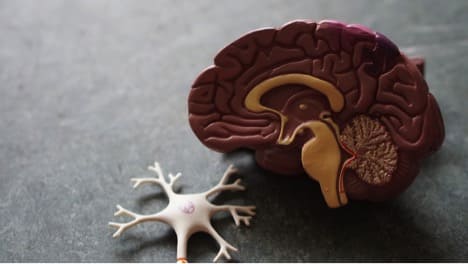Nerve Pain: a Pain Like No Other
14
July
2021

It's all in your head, literally
Nerve pain, also known as neuropathic pain, isn't usually caused by an incident or injury. Instead, your body delivers pain signals to your brain without prompting.
Neuropathic pain arises when a health problem affects the nerves that convey sensation to the brain. So why is it different from any other kind of pain? If you have non-neuropathic pain (nociceptive), it is usually caused by an accident, injury, or disease. For instance, Holland explains it as so, "if you drop a heavy book on your foot, your nervous system sends signals of pain immediately after the book hits." However, if you have chronic neuropathic pain, it can flare up at any place and time, even if there is no visible source of pain. Nerve pain comes in various forms, including:
Postherpetic: it can affect the same region after you've had the shingles rash
Trigeminal: pain in the jaw or cheek
Occipital: pain in the base of the skull that can extend to the rear of the head
Pudendal: pain in the saddle region between the thighs

What causes these types of pain?
Problems with the central nervous system, located in the brain and spinal cord or the nerves that flow to the muscles and organs can cause nerve pain. The most frequent causes of neuropathic pain fall into four categories: disease, injury, infection, and limb loss. Keep on reading if you want to know more.
-
Disease
Diabetes: According to the Cleveland Clinic, diabetes is responsible for 30% of neuropathic cases as it may affect how your nerves operate. People with diabetes frequently suffer numbness and loss of sensation in their limbs and fingers, followed by pain, burning, and stinging.
Long-term excessive alcohol intake: Over time, it can lead to various problems, including chronic neuropathic pain and nerve damage. If the latter is caused by persistent alcohol usage, it can have long-term effects and severe pain.
Trigeminal neuralgia: A painful disease characterized by significant facial neuropathic pain on one side. It's one of the most frequent kinds of neuropathic pain, and it can strike for no apparent cause.
Types of cancer: neuropathic pain can be a symptom or a side effect of various illnesses and disorders. Multiple sclerosis, multiple myeloma, and different other types of cancer are among them. Although neuropathic pain does not affect everyone with these diseases, it can be a problem for some.
Cancer treatments: It might result in neuropathic pain. Chemotherapy and radiation can both harm the neurological system, resulting in unusual pain signals.
-
Injury
Tissue, muscle, or joint injuries are a rare cause of neuropathic pain and back, leg, and hip issues or traumas, which can cause nerve damage. Even if the injury heals, the neurological system damage may not. Therefore, you might have to experience long-term pain and discomfort following the injury.
Accidents or injuries to the spine can also result in neuropathic pain. Herniated discs and spinal cord compression might damage nerve fibers surrounding your spine.
-
Infection
Shingles caused by the chickenpox virus reactivating can produce neuropathic pain along a nerve for several weeks. Postherpetic neuralgia is an uncommon shingles condition that causes chronic neuropathic pain.
A syphilis infection can sometimes cause inexplicable burning and stinging pain.
HIV patients may also experience this inexplicable discomfort.
-
Limb loss
When an arm or leg is amputated, phantom limb syndrome occurs, a rare kind of neuropathic pain. Even though the limb has been removed, your brain continues to believe it is getting pain signals from the removed body part.
However, what's going on is that the nerves surrounding the amputation are misfiring and delivering false signals to your brain.
Keep in mind that phantom pain can be felt in the fingers, toes, penis, ears, and other body regions in addition to the arms and legs.
-
Other causes
Lack of vitamin B
Carpal tunnel syndrome (CTS)
Thyroid issues
Issues with the facial nerves
Spinal arthritis

What are some of the most common symptoms?
Symptoms of neuropathic pain vary from person to person, but they mainly include:
Shooting, burning or stabbing pain.
Tingling and numbness, or a "pins and needles" sensation
Spontaneous pain or pain that occurs without a trigger
Evoked pain, or pain caused by typically not painful events, such as rubbing against something, being in cold temperatures, or brushing your hair.
A persistent uncomfortable or unusual sensation
Trouble sleeping or resting
Emotional issues resulting from chronic pain and sleep deprivation, such as anger and frustration and difficulty articulating what you're feeling, can sometimes cause anxiety and depression.
How is neuropathic pain diagnosed?
The first step your doctor takes to diagnose your condition is to ask you about your symptoms, medical history and examine you.
They will most likely test your nerves by assessing your muscular strength, evaluating your reflexes, and determining how sensitive you are to touch throughout the physical examination.
Depending on what your doctor suspects, you may be required to take tests such as:
Blood tests to assess your overall health and rule out any underlying issues
Nerve conduction tests are used to determine how fast electrical signals are transmitted through your nerves.
A CT scan or an MRI scan to search for anything pushing against a nerve
What are possible treatments?
The objective of neuropathic pain treatment is to determine the underlying disease or condition causing the pain and, if feasible, treat it.
Diabetes, for instance, is a prevalent cause of neuropathic pain. If that is your case, it can be eliminated or reduced with proper diabetes management, including a balanced diet and frequent exercise. In addition, maintaining blood sugar levels can also help to avoid pain and numbness from getting worse.
Bear in mind that your doctor's primary goal is to give pain relief, assist you in maintaining your standard capabilities despite the pain, and enhance your quality of life.
The following are the most frequent neuropathic pain treatments:
-
Medicine
Over-the-counter medication: Neuropathic pain is sometimes treated with nonsteroidal anti-inflammatory drugs (NSAIDs), such as Aleve and Motrin. Many people, however, believe that these medications are ineffective for neuropathic pain since they do not address the root of the problem.
Prescription medication: Doctors may be hesitant to prescribe opioid pain relievers because they don't always work as effectively for neuropathic pain as other forms of pain. They also fear the patient might become dependent on them. On the other hand, topical pain medications are also an option. Lidocaine patches, capsaicin patches, and prescription-strength ointments and lotions are examples of these.
Antidepressant drugs: They have proved to be effective in alleviating neuropathic pain. Patients usually take one of two kinds of antidepressants:
Serotonin-norepinephrine reuptake inhibitors
Tricyclic antidepressants.
These may help with pain and the feelings of sadness or anxiety brought on by chronic pain.
Anticonvulsants: Anticonvulsants and anti-seizure medicines are frequently used to treat neuropathic pain. Gabapentinoids are the most prevalently used to treat this condition. Although it's unclear why anti-seizure meds help with verve pain, scientists believe they operate by interfering with pain impulses and preventing false transmissions.
Nerve blocks. Steroids, local anesthetics, or other pain medications may be injected into the nerves suspected to be causing the faulty pain signals. However, they must be induced repeatedly to continue operating because their effect is only temporary.
-
Lifestyle treatments
These treatments can assist patients in comprehending and coping with their pain. They are as follows:
Exercises
Acupuncture
Relaxation techniques
Physical therapy
Massage therapies
Psychological treatments
These treatments can all help you feel in control of your pain, reduce stress, relieve symptoms, and help ease your muscles.
-
Implantable device
A surgeon must implant a device in your body during this invasive operation. Some devices are embedded in the brain, while others are embedded in the spine.
The device can deliver electrical impulses into the brain, spinal cord, or nerves once implanted. The stimulants may be used to manage symptoms by stopping the irregular nerve signals.
However, this device is usually only reserved for those who haven't reacted well to previous treatments.
-
Multimodal therapy
A multipronged strategy to treating your nerve pain can be successful. A mix of medicines, physical therapy, psychological treatment, and even surgery or implants may be employed to get the most significant outcomes. Your doctor will suggest this approach depending on your condition.
Be cautious!
If you don't manage neuropathic pain and prevent it from getting worse, it might negatively influence your life.
This can lead to significant impairment and difficulties over time, such as depression, sleeping problems, anxiety, and more.
The good news is that researchers are learning more about the causes of neuropathic pain and what can be done to cure it effectively. As a result, better therapeutic alternatives are becoming available.
It may take some time to identify the best treatment choices for you, so be patient because you and your doctor can work hand in hand to alleviate the symptoms of this painful disease.
If you or anyone you know is suffering from pain, call us today on (469) 562 4188 to book an appointment with our expert doctors.